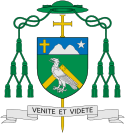David Monroe
David John James Monroe (* 14. April 1941 in Vancouver, British Columbia, Kanada) ist ein kanadischer Geistlicher und emeritierter römisch-katholischer Bischof von Kamloops.
Leben
David Monroe empfing am 20. Mai 1967 das Sakrament der Priesterweihe für das Erzbistum Vancouver.
Am 5. Januar 2002 ernannte ihn Papst Johannes Paul II. zum Bischof von Kamloops. Der Erzbischof von Vancouver, Adam Joseph Exner OMI, spendete ihm am 12. März desselben Jahres die Bischofsweihe; Mitkonsekratoren waren der Bischof von Victoria, Raymond Roussin SM, und der Erzbischof von Regina, Peter Joseph Mallon. Die Amtseinführung erfolgte am 18. März 2002.
Papst Franziskus nahm am 1. Juni 2016 seinen altersbedingten Rücktritt an.[1]
Weblinks
- Eintrag zu David Monroe auf catholic-hierarchy.org
Einzelnachweise
- ↑ Rinuncia del Vescovo di Kamloops (Canada) e nomina del successore. In: Tägliches Bulletin. Presseamt des Heiligen Stuhls, 1. Juni 2016, abgerufen am 1. Juni 2016 (italienisch).
| Vorgänger | Amt | Nachfolger |
|---|---|---|
| Lawrence Sabatini CS | Bischof von Kamloops 2002–2016 | Joseph Nguyen |
| Personendaten | |
|---|---|
| NAME | Monroe, David |
| ALTERNATIVNAMEN | Monroe, David John James (vollständiger Name) |
| KURZBESCHREIBUNG | kanadischer Geistlicher, emeritierter Bischof von Kamloops |
| GEBURTSDATUM | 14. April 1941 |
| GEBURTSORT | Vancouver, British Columbia, Kanada |
Auf dieser Seite verwendete Medien
(c) I, SajoR, CC BY-SA 2.5
Coat of arms of the Canadian Bishop David John James Monroe, Bishop of Kamloops.
COAT OF ARMS
Mountains are common to Vancouver (the Lions), where I grew up and where I have been a priest, and to Kamloops (Mount Peter and Paul). Major events in the life of Jesus take place on the mountain: as disciples, we come and see Him in the ‘Sermon on the Mount’; on the mountain we find Jesus in prayer; there we see His divinity in the Transfiguration, and His humanity on Calvary. Jesus is the mountain we ascend in our spiritual life. The star is a symbol of Mary, the “Morning Star” and the ‘ Star of Evangelization’ (Pope John Paul II). She is the patroness of both the Archdiocese of Vancouver under the title of Our Lady of the Most Holy Rosary, and the Diocese of Kamloops under the title of the Immaculate Heart of Mary. The cross is central in Jesus’ invitation to come and see, and the eagle, known for its keen vision, looks toward the cross. The eagle is the symbol of St. John the apostle, from whose Gospel motto, “Come and See,” has been taken. St. John the Apostle is the patron of the parish where I was born and last served as pastor. The eagle is also part of the Munro (Monroe) clan. Behind the eagle the carpenter’s square, a symbol of St. Joseph, patron of Canada. In the cross, star and square we have the Holy Family – Jesus, Mary and Joseph.
MOTTO – “Venite et Videte” (“Come and See”) – is taken from the Gospel of Saint John (1:35-39/1:46/4:29). Two disciples, one of whom was probably the evangelist John, left John the Baptist to follow Jesus. Jesus asked them, “What do you seek?” They replied, “Teacher, where are you staying?” Jesus said to them, “Come and see.” Jesus issues this invitation to everyone who wants to be His disciple. His invitation means more than going down the block and visiting Jesus for a while: it means having the company of Jesus on our life’s journey: seeing Jesus as Philip did when he said to Nathaniel, “Come and See” (“Veni et Vide”); or as the woman of Samaria told the people of the city to “Come and See.” Jesus invites us to be God’s children now, and, at the end of our earthly journey, to come to Him in Heaven and “See God as he really is (1 John 3:1-2)
Reference:

